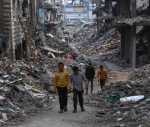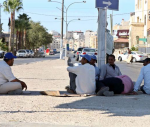You are here
Analysing terrorism from Hebron to Christchurch
Mar 31,2019 - Last updated at Mar 31,2019
In response to the Christchurch tragedy, the Organisation of Islamic Cooperation (OIC) foreign ministers held an emergency meeting in Istanbul on March 22, and condemned in the strongest possible terms such horrendous and despicable Islamophobic terrorist attacks.
It has become another darkest day for all of us. The world was once again severely shocked following a mass shooting at two mosques in a tiny city of New Zealand. This horrific attack and massacre of Muslim worshippers during a Friday prayer was similar to previous terror acts that occurred in many parts of the world in the last few years, either conducted by the Al Qaeda network or inspired by Daesh ideology.
It is a fact that there is not a single individual, nor any party, who is able to detect when, where or by whom such a terror act will happen. It is a reminder that no country is immune from terrorism.
In accordance to the United Nations Global Counterterrorism Strategy (UNGCTS), adopted in 2006, terrorism in all its forms and manifestations must be condemned in its strongest terms. All acts of terror by whomever, whenever and for whatever reasons constitute a serious threat to international peace and security.
In line with one of the principles contained in the UNGCTS, terrorism cannot, and should not, be associated with any religion, nationality, civilisation or ethnic group. Although the international community has adopted such a strategy, a series of terror acts are still unavoidable and took place not only in big cities, but also in small cities. Below are some instances about the said presumption on terrorism.
In the month of Ramadan on February 25, 1994, during a dawn prayer at Ibrahimi Mosque in Hebron, Baruch Goldstein, a Jewish extremist settler, with a semi-automatic weapon opened fire indiscriminately towards 800 Muslim worshippers. As a result, 29 Palestinians died on the spot and 125 were seriously wounded. At the end, he was beaten and killed by the rest of the worshippers in the mosque area. This tragic incident then provoked a week of clash that killed more 20 civilians and injured 120 Palestinians because of Israeli excessive use of arms.
At the tiny island of Utoya, about 40 kilometres from Oslo, another tragic incident happened. It was recorded as the most terrible act of terror in the history of Norway since World War II. On July 22, 2011, Norwegian Anders Behring Breivik, disguised as a police officer, entered a summer camp in the island and conducted a mass shooting towards more than 700 youths who were camping. As a consequence, 69 youths and teenagers died on the spot. After the arrest, he claimed that he is anti-Islam and wanted to expel all Muslims from Europe.
On October 1, 2017, another horrible terror act took place in the city of gambling, Las Vegas. That evening, when about 200,000 people gathered to watch a musical concert, Stephen Craig Paddock opened fire from the window of a nearby hotel directed to the audience. It was very shocking when 59 people died and other 850 were wounded. After killing those innocent people, before police arrived, he shot and killed himself. This massacre was documented as the most disastrous event in the US history caused by a single killer.
In Surabaya, the second largest city of Indonesia, on May, 13 2018, three churches were attacked separately around the same time by suicide bombers. Ten Christian worshippers died and 40 others were injured. The perpetrator, Dita Upriyanto, was accompanied by his wife and four children. Upriyanto and his family had just returned from Syria, where they joined as Daesh fighters, before perpetrating this extremist attack. This was an unprecedented terror act, in which a whole radicalised family committed to such a heinous attack.
In a remote small city of Squirrel Hill in Pittsburgh, Pennsylvania, on the morning of October 27, 2018, a middle-aged man named Robert Gregory Bowers opened fire at a synagogue when the Jewish community were worshipping to celebrate the Shabbat Day. The casualties were 11 Jewish people killed and many others wounded. After his arrest, Robert was found to be an anti-Semite, a white supremacist and a neo-Nazi sympathiser.
And recently, a young man named Brenton Tarrant, an Australian who claimed to be an anti-Islam, anti-immigrant and a white-supremacist, wearing a military uniform and putting a video camera on his helmet, committed a mass shooting in two mosques in the tiny city of Christchurch, New Zealand. Unbelievable and unprecedented, he was filming his action when he murdered 50 innocent Muslims and injured more than 40 other worshippers. In the words of New Zealand Prime Minister Jacinda Ardern, it was the darkest day in the history of this Kiwi state.
From the abovementioned series of terror acts, it can be analysed that the form and manifestation of such acts are different, including the perpetrators, the victims and the triggering factors. However, despite the differences, if we scrutinise from the character of those terror acts, we can find some commonalities.
From the view of perpetrator, all the terror acts were committed by a single actor, except in the case of churches attack in Surabaya. In the dictionary of terrorism, it was usually called a lone-wolfer. The perpetrators also have different religious backgrounds. They were Jewish, Christian, Muslim or even atheist.
From the view of victim, except those in Utoya Island and Las Vegas, the victims were worshippers who were conducting their religious rituals. During the attack at the mosques in Hebron and Christchurch, the victims were Muslims. Meanwhile, in Surabaya case, the victims were Christian and at the synagogue incident in Pittsburgh, they were all Jews.
From the view of triggering factor, it seems that the perpetrator was incited by certain ideology and faith. There were those who claimed themselves as anti-Islam, anti-Semite, anti-immigrant and white supremacists. This can be seen in the case that happened in the island of Utoya, Pittsburgh and Christchurch. There was also a perpetrator family who joined Daesh and member of a terrorist network.
In conclusion, a proposition on terrorism based on the principles as contained in the UNGCTS remains relevant. First, the act of terrorism in all its forms and manifestation must be condemned in its strongest terms. Whoever the perpetrator, wherever the location of such acts and whatever triggering factors, terrorism is unjustifiable and unacceptable. Second, the act of terror from the case in Hebron to the one in Christchurch, is proven that it cannot be, or should not, be associated with any religion, nationality, civilisation or ethnic group. And third, and more importantly, how can we address the conditions conducive or the root causes of the spread of terrorism, radicalism and extremism. Pluralism and tolerance must be highly upheld and pursued by ensuring the respect for all religions, values, beliefs and cultures.
From the aforementioned cases and conclusion, a presumption that always cornering terrorism to be identical with certain religion or religious group is factually unjustified. The OIC foreign ministers also urged all countries that have Muslim communities and migrants to refrain from all policies, statements and practices that associate Islam with terror, extremism and threats to society.
Furthermore, let us contemplate the essence and meaning of pluralism and tolerance in our nationhood. Let us move away from taunting and avoid hate speech based on any religion/religious group, if we do not want such barbaric and horrible acts of terror, like the one in Hebron and to up to Christchurch, to happen again in the future.
The writer is the ambassador of Indonesia to Jordan and Palestine. He was the director of International Security and Disarmament at the Ministry of Foreign Affairs of Indonesia (2013-2017)












